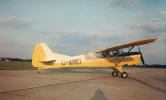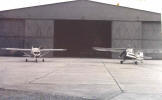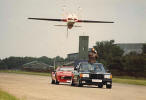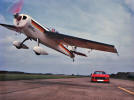CONTENTS: CHAPTER 1 - THE EARLY DAYS: (THE FOLLOWING IS EXTRACTED FROM AN OLD CLUB ALBUM CURRENTLY IN THE POSSESSION OF FORMER MEMBER ROGER GOODWIN. IT COVERS THE PERIOD FROM FORMATION TO EASTER 1970): "The RAF Laarbruch Flying Club was formed in the summer of 1967 by Major Nick Nichols of the Army's 21st Signals Regiment, based at the station. Its' first aircraft was an old Auster 3, G-AREI, commonly referred to as "The Yellow Peril," and with it flying training began. 

(KEITH DUFFY adds: Actually, there was a Flying Club at Laarbruch prior to 1967, but it folded due to lack of interest, leaving a Percival Prentice and a Tiger Moth languishing in the back of the Gliding Club hangar. The Station Commander was of the opinion that the Tiger Moth was too old fashioned to teach people to fly and had it taken outside and burned. (ED: Sacrilege !!!) Nick Nichols was trying to resurrect the club and was told that he could do so if he could obtain £100 for the Prentice. It was in such a state that this was considered impossible, but it did not deter a man of Nick's calibre. He asked Ian Smith if he could make it fly, and Ian roped me in to sort out the engine while he worked on the airframe. The thing looked like something out of a cartoon, a list to port, flat tyres and peeling paint. The scavenge filter was full of bits of piston ring and the airframe was worse. We could not afford to buy proper piston rings with the correct bits of paper so I seem to remember that we used Chevrolet motor car rings which fitted give or take an inch. It took Ian three days to get the canopy off and I also remember that among other repairs he fabricated a tail wheel axle from one the hanger door bolts. Anyway, we eventually got the beast airborne in a cloud of smoke that the Red Arrows would have been proud of - the Gypsy didn't like the Chevrolet piston rings - and Nick set off for the UK clutching a rubber boat and a parachute. He never did get the gong he so richly deserved! He sold the Prentice for £100 and bought G-AREI from (the then famous) Major Mike Somerton-Rayner who had flown it back from Malaya. We used to refer to it as Mark 3 1/2 because although it started life as a Mk. 3, so we understood, Somerton-Rayner had put it back together in Malaya using bits from several marks, including the wings from a Mark 6.) "Later that year Squadron Leader 'Phil' Phillips was posted in and within 24 hours of arrival was installed as Chief Flying Instructor of the club. Within six months of his arrival the first four pilots received their PPL's. "With the only aircraft grounded for three months through lack of spares, and restricted by bad weather during the winter, getting in sufficient flying time was rather difficult. (PETE YOUNG ADDS: The Yellow Peril was not certified as airworthy but Phil was one of the very few RAF pilots who were also qualified engineering officers. We had spent some time working on G-AREI and he wanted to do a taxi test and invited me along. This I remember being carried out at 1000ft around the taxiways.) "Nevertheless the members did not waste their time or energy but channelled it in other directions, namely the club house and the bar. "However, some months later, another Auster 3 G-ATAX was obtained which, owing to an unscheduled ground-loop, needed a complete overhaul. "Now the two main tasks which the club members faced were the completion of the bar, and the cannibalisation of the two Austers to produce one airworthy aircraft. Both tasks were achieved with immense success. "So came the big day and a completely rejuvenated, all-singing all-dancing G-ATAX was rolled out of the hangar "Flying training was continued but the big problem now was how to cater for an ever-expanding student list. "Simple, get another aircraft. The wheels were set in motion and with the assistance of The Nuffield Trust another aircraft was obtained. 

"This aircraft turned out to be a Bolkow Junior 208C G-ATVX which was used as an advanced trainer. "Life went on, and as more and more students passed their FHTs and became PPL holders, someone (Phil) decided it would be a great idea if the Cranwell Flying Club could come to Laarbruch for an Easter Rally. "This idea was duly implemented and during Easter 1969, Cranwell sent two Tigers for the Rally. _small.gif)

"The Rally was such a success that it was decided for the following year to extend invitations to other private flyers in the UK. So Easter 1970 saw the arrival of 10 light aircraft from the UK." MORE PHOTOGRAPHS FROM THIS ALBUM, COVERING THE EARLY DAYS OF THE CLUB, ARE INCLUDED IN THE PHOTOGRAPHIC SECTION OF THIS SITE. .gif)
CHAPTER 2 - THE 1970'S On completion of his tour, Phil Phillips, who had done more than anyone to establish the club on a firm footing, handed over as QFI to Flt Lt Graham Chilvers, the squadron test pilot on No 16 Squadron (Canberras). Training continued, and a major stage in the development of the club came with the acquisition of an ex-Luftwaffe Dornier Do 27. One of the most active club members at the time was a serving Luftwaffe Major, Wulf Ehrhardt. The Luftwaffe was in the process of disposing of its fleet of Do 27 liaison and communications aircraft, and Wulf arranged for one of them to be released to the club at a knock-down price. The Dornier was a different order of business from the Auster and Bolkow. This was a real grown-up aeroplane and not really suitable for the basic training role. Instead it was kept busy earning its keep chucking out parachutists and as a chariot to and from UK. (Click here to read BOB SWAINSON'S account of pioneering parachuting with the club in those days) Sadly, the Dornier was also to figure in the worst incident and greatest tragedy that the club experienced. Following the success of the two earlier rallies, it was decided to hold a third during the Whitsun Bank Holiday 1971. On 28 May 1971, while practising for a low level display for the rally, the Dornier crashed in the middle of the airfield, killing Graham Chilvers and his passenger Gerry Kingwill, a fellow pilot on No 16 Squadron. Graham, a popular and highly effective CFI, left a wife and two very young children. No-one felt much like carrying on with the rally, and indeed the Laarbruch station commander, Group Captain Beddows, wanted it cancelled. But 12 aircraft were already airborne en route to Germany from UK, so the show had to go on, albeit with a much curtailed programme and in a very sombre atmosphere. Graham was replaced as CFI by Flt Lt John Bent, an ex-V-bomber pilot then suffering a ground tour as an ops officer. John faced the difficult task of revitalising a demoralised club. Without his energy and enthusiasm it is questionable whether indeed it would have survived - which, largely thanks to John, it did with conspicuous success. Training continued with students from all over Germany queuing up for flight time. As ever the problem was keeping sufficient flying hours available in the programme to meet the demand. The aged Auster spent more and more time in the hangar, which effectively placed the whole load on the single Bolkow. Sometimes even routine servicing could stop flying for several weeks. The time had come for the Auster to move on to a less demanding home, and she was sold on to a Cornish owner who based her at Bodmin airfield, Cornwall. (AL LEMON WRITES: I well remember flying her home for sale across the channel in un-forecast thunder storms when the engine changed note slightly. Our planned UK destination on the South Coast was out in hail and thunder. The aircraft had no radio, of course, so I diverted to Manston, arriving unannounced on the main runway under a 100-foot cloud base. Air Traffic didn't know that I had landed until I phoned them from the refueller's tea bar. They were just about to get the air sea rescue chopper up as we were posted overdue and without a radio no one knew where we were. The sobering thing was that on shut down whilst checking the mags I got a dead cut on one set, which was why the engine note changed mid-channel. That's why that trip is very firmly fixed in my memory!!!) The Club decided to replace the Auster by standardising the fleet on the popular Bolkow Junior, so on 11 November 1972 John Bent flew in a second example, G-ACGX. The Gods of the English Channel must have been in a benign and forgiving mood that year, at least so far as the LFC was concerned. As John flew her across the watery miles of the Channel from Southend, it is as well that he did not know what was brewing under the bonnet. The next day club member John Chorley flew her to Kamp Lintfort, a local German flying club with which the LFC always enjoyed good relations. On the return flight John, a newly-qualified PPL, had the character-forming experience of an engine failure after take off when she spat out an improperly-tightened spark plug. He successfully put her down in a ploughed field where inevitably she flipped, leaving him trapped upside-down in the cockpit for a heart-stoppingly lengthy period before he could be rescued. Thus ended GX's service with the club - less than 24 hours. John Chorley, meanwhile, gets jumpy at the smell of petrol to this day. John Bent's tour was drawing to an end and in early 1973 he left Laarbruch, and shortly after the RAF, to embark on what was to become a distinguished career in civil aviation. His place as CFI was taken over by Flt Lt Ian Thomas, another GD Pilot suffering withdrawal symptoms on a ground tour as an Ops Officer. With the club once again down to a single aircraft, the faithful Bolkow Junior G-ATVX, steps were again taken to acquire a second machine. This time a different direction was taken, and in due course Piper Caribbean G-AREL appeared. The Caribbean - essentially a poshed-up Tri-Pacer - was the club's first four-seat aircraft since the Dornier, and the first in the club's history which could be flown by the club's PPL's. At last, club members had the chance to fly friends and relatives as passengers. Even so, "away-days" had to be organised in order to do it, as the burdensome and overly-restrictive regulations still imposed in those days by RAF and MOD bureaucracy, prevented doing so from an active airbase. Perhaps it was a blessing in disguise, because the Club "Fly-Away" weekends organised for some of the 1973 Bank Holiday weekends were a great success. Expeditions included a memorable weekend spent enjoying the scenery and hospitality of the Moselle region, with the aircraft based at Koblenz and venturing out to other local airfields in the region. ANDREW POOLEY writes: When I first joined the club in 76 we were based at the old flying control tower and the club house and bar was a reconditioned 2Sqn RIC building that was formally the crew room of the RIC. This building had been damaged by a fire and was scrapped by the station, acquired by the club, refurbished and attached to the old tower. ( More information needed to cover the late 1970's. Please contact Webmaster) .gif)
CHAPTER 3 - THE 1980'S PHIL MUMMERY writes: I joined in early 1980 and was placed on the flying waiting list as the club was somewhat oversubscribed at the time. By then the club was firmly established in the refurbished portacabin attached to the old Control Tower. My first flight as I recall was with a gent called John McVein (not sure about the spelling) who took me up for a spin (literally) and some aerobatics, in Cessna 152 aerobat G-BBKV. The fleet consisted at this time of three Cessna’s: G-BBKV (Cessna 150 Aerobat), G-AVIA (Cessna 150) and G-LOOK (Cessna 172) My first lesson was in G-AVIA on 15th June 1980 with the then CFI of the club Sqn Ldr Robin Williams, who succeeded the previous CFI Derek Bridge. A few weeks later on 17th August I was sent solo by Sqn Ldr Rod Harrison (presumably because he just wanted to get out…) on the C172 G-LOOK. A few months after that this same wonderful chap conducted my General Flight Test (as we called it then) and declared that I was fit to be declared a fully fledged PPL. A few other names spring to mind; on the engineering side Gavin Johnston was overseeing maintenance while the ’Oilies’ carried out most of the hands on stuff. These included Chief Tech Angus Murray who also lent much support to the maintenance of the bar profits along with the rest of us... Wg Cdr Derek Day was another keen supporter of flying and social functions while Dave Shepherd and Larry Harris looked after the bar. Another prominent member was Corporal Arlwyn Jones who amidst much guffawing from the RAF hierarchy managed (I believe) to become the first Non Commissioned Officer to be allowed to be able to teach people to fly at an RAF flying club. Later came Tim Storrs an Air Load Master from Gutersloh who devoted probably all his weekends during his entire tour to instructing at Laarbruch. Other instructors at the time included George Lee, Chris Marshall, John Sims and Tref Williams (to succeed Robin Williams as CFI). I look back with fondness on my time at ‘RAF Laarbruch Flying Club’ (the real name) especially as it led to shaping my own career in aviation. I revisited Laarbruch in August 2005, a trip on which I clocked up my 10,000th hour, although I didn’t realise it until I returned to UK. Having logged my very first hour at Laarbruch, how spooky is that? I tried calling ‘Laarbruch Civil’ on 119.7 but I didn’t get a reply... PETE CORNTHWAITE writes: I was a member from early 82 to October 84. I got my PPL in May 82 having also been taught by Tim Storrs who after his RAF career as a Loadmaster on Pumas, I believe went onto to fly with BA. I became the Chairman of the Club in late 82 until I was posted- Glyn Rowlands was the Treasurer – he went onto fly with Emirates. Other names I remember include Les Fellows , now heading up the CBT team at Oxford Air Training, and still flying with the Volunteer Gliding Squadron at Halton. They were great times, especially the Rallies we held every year and the `dawn patrol’ on the Sunday morning following the party !!! The story behind the TV advert (see pictures and references below) is that Walter Extra wanted to do a photo shoot for his `new’ aerobatic aircraft. We were told that there were going to be girls from Playboy there, which is why the Station Commander OK’d the visit! The flying was fantastic - and very hairy! The world aerobatic champion at the time, the Swiss Eric Muller, was also there on the day and he gave me a flight in his Bucker Jungmeister - aeros over the camp - unforgettable - not least because my straps weren't tight enough. I've never been so scared in my life as we flew inverted with me hanging on to the seat pan! CHRIS LAZENBY writes: I joined the Club in August 84, stayed until March 86 and had a great time, at least that's what I've been told. Perhaps it was the Grolsch and not the Alzheimers that did my memory in! 

Clive Wright had recently taken over as OC the club and Bruce Monk was CFI. We had various instructors, Tim Storrs was an ALM from Gutersloh, Piers Colvin was a XV Squadron Tornado pilot, John Hurrell was on one of his many Tonka tours and Tim Turnbull was OC Simulators I believe. Gordon Parkin was the spannerman. The aeroplanes when I arrived were the two Cessna 150's, G-BBKV and G-BCUY, and Cessna 172 G-LOOK. Sadly she didn't last too long as somebody flipped her on her back after getting into PIO's ( A Tornado Pilot !!). The two Slingsbys arrived soon after with a replacement 172, G-BBKC.I've been flying all over the world since then, but 9000 hours later my favourite time in aviation is still those 20 months in Germany. It was that kind of a club - great! These days I am trying to get back into light aircraft flying but I know it won't be the same, its the people that make it.(PETE CORNTHWAITE, then the Club Chairman, adds: The story of the Slingsbys is that in early 1984 we were looking to replacing the Cessna Aerobats then used for training. We flew over to Biggin Hill to look at a Piper Tomahawk and a Slingsby. The Slingsby was good and it eventually led to us managing to negotiate a lease purchase with Slingsby for the two we finally finished up with. The rates were very favourable. Slingsby at the time were desperate to get into the MOD market for the primary trainer and I think they saw the deal with us as gaining a toe-hold.) (ED: For more info on the early days of the Slingsbys, see below.) PIERS COLVIN adds: I instructed on the club while I was based at Laarbruch flying Tornados with XV Squadron from 1983-86 - indeed at one time I was the only instructor! I remember those Ferrari / Merc aerobatics very well !! 

I well remember the business of buying the two Slingsby's. Slingsby Aircraft lent us a T67M for a while before we bought the T67B's. This was great fun. John Hurrell and myself returned it to the UK factory at Kirbymoorside to pick up our first B, which to be honest was quite a disappointment after the M with it's inverted fuel and oil systems, extra power and constant speed prop. At some point in the 1980's, the club's name was changed to The Neiderrhein Powered Flying Club (NPFC). ANDREW POOLEY writes: In 1988 I was posted back to Laarbruch on appointment as OC 2 Sqn Recce Intelligence Centre. I was volunteered(!) to take over the club and remained OC until my posting back to UK in 1991 and subsequent retirement from the RAF. I had a turbulent two years in charge of the club with aircraft engine failures in the air and general unserviceabilities. In 1988 2 Squadron was changing over to the all electronic Tornado. The RIC buildings were going to be scrapped and I acquired two of them and positioned them at the other two "ports" of the Club's existing ex-RIC building at the Control tower. We therefore had extensive flight planning and office accommodation for the club. We also built the new clubhouse and refurbished the old. I took over the club with one aircraft out of action due to a collapsed nose wheel accident. However, with the help of an engineering officer, Flt Lt Rolly Dixon ( my future brother in-law) we kept the fleet of three aircraft airborne for much of the time. We ran two Slingsbys and a four-seat Cessna that we used for touring. We not only managed to keep the fleet running (despite many problems) until I left Laarbruch in 91, but also held two very successful annual fly-ins with over 40 aircraft attending on one occasion. .gif)
CHAPTER 4 - THE 1990'S AND THE FINAL DAYS ( More information needed to cover the period 1991-95. Please contact Webmaster) BOB McCLOUD, the club's last Chief Pilot and Officer in Charge, writes: I was posted to RAF Laarbruch in September 1995 as OC Helicopter Support Squadron and, later OC Harrier GR7 Simulator. Within a month of arriving, I had taken over as Officer in Charge of the Club from Tim Smith, a Harrier pilot who was about to retire. The fleet at that time was a Slingsby T67b (G-BLTU), a Cessna172 (G-BBKC) and a Robin DR400 Regent (G-FTIL). The Robin had been purchased, in part, in 1994 by selling of one of the Slingsby T67 (G-BLPI) for £26K from the fleet that Oliver operated during his tenure. By 1995, the annual Laarbruch Rally had become established as a popular and rewarding activity that was held during each Easter week-end. Unfortunately our Cessna 172 Kilo Charlie was written-off during a landing accident at Arnsberg during the 1996 Rally weekend. The Club had developed a good balance between PPL and instructional flying, but it soon became difficult to provide continuity to the student pilots with only one training aircraft. Consequently, the Club bought back G-BLPI for £24K in August 1997 – during its time away from the Club, the aircraft had it’s bad-taste re-spray (see engineer Kevin O'Neill's comments in Papa India's entry on the aircraft page) , the expensive walkway strengthening AD, new seat upholstery and very few hours flown since it’s departure from Germany. Bargain. To my mind, the Club now had the ideal fleet – two nearly identical trainers for instruction and a fast touring aircraft for the PPLs. The Last Laarbruch Rally ever was held during the August Bank Holiday in 1998. We fielded 45 aircraft and 136 participants – unknowingly during the same weekend as the Dutch equivalent of the Tour de France. Finding sufficient hotel bed space was a challenge! This event represented the last significant social get-together as some members had already been posted as Laarbruch drew down. I cannot comment on the change of name from Laarbruch Flying Club to Niederrhein Powered Flying Club – it was before my time. However, the Club had a name change in 1998 because a local resident complained about light aircraft noise nuisance and challenged the legality of the Club’s operation since the Club was not registered with the German CAA equivalent. It must have taken some effort on his part to establish that fact! Consequently, and on the advice of the Civilian Liaison Officer, the Club became the RAF Germany Flying Training Centre – which made it sound as if we were conducting formal military flying training. It worked – and we weren’t shut down! It was decided that the Club would move to Bruggen to provide about two years extra life before Bruggen itself was handed over to the Army. Sadly, however, Bruggen got cold feet just one month before the move so a new home for the Club's aircraft and assets had to be found – and quickly. Wyton was selected as the Pathfinder Flying Club was already operating a leased T67b and the airfield is not far from CotWit where many of the ex Laarbruch members had been posted. So in a sense the Club lives on even yet. All the Club assets were gifted to Wyton and the coffee bar has a display of the Laarbruch memorabilia including the photo album. I’m sure that the PFC would allow nostalgic visits by ex Laarbruch Club members! (For the latest news, check the Pathfinder Club web-site via the link on our links page) .gif)
|